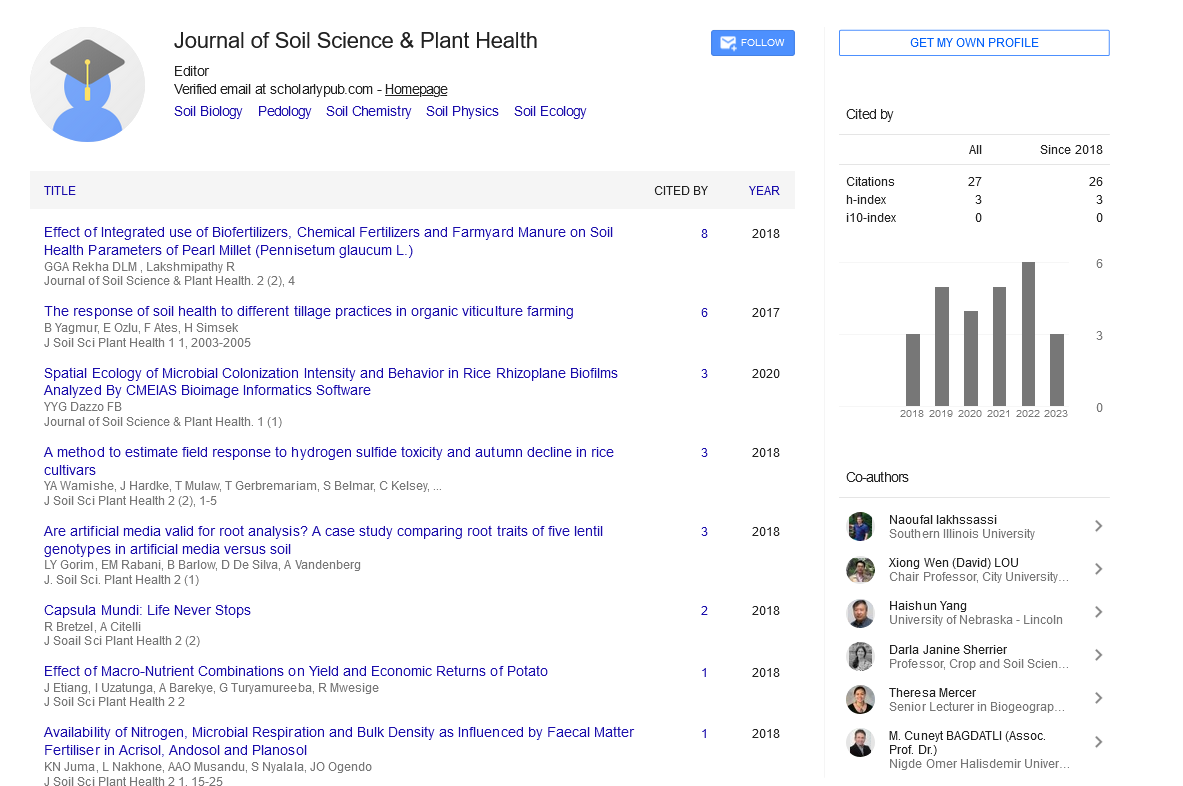Editorial, J Soil Sci Plant Health Vol: 7 Issue: -1
Soil Grids: Revolutionizing Global Soil Information
Maria LuÃsa*
Department of Geology and Soil Science, University of Lisbon, Portugal
- *Corresponding Author:
- Maria LuÃsa
Department of Geology and Soil Science, University of Lisbon, Portugal
E-mail: maria146@gmail.com
Received: 01-Feb-2025, Manuscript No. Jsph-25-170181; Editor assigned: 4-Feb-2025, Pre-QC No. Jsph-25-170181 (PQ); Reviewed: 18-Feb-2025, QC No. Jsph-25-170181; Revised: 25-Feb-2025, Manuscript No. Jsph-25- 170181 (R); Published: 28-Feb-2025, DOI: 10.4172/jsph.1000212
Citation: Maria L (2025) Soil Grids: Revolutionizing Global Soil Information. J Soil Sci Plant Health 7: 212
Introduction
Soil is a fundamental natural resource that underpins food security, biodiversity, climate regulation, and ecosystem services. However, accurate, high-resolution, and globally consistent soil information has long been a challenge for researchers, farmers, and policymakers. In response to this need, SoilGrids emerged as a cutting-edge, open-access platform that uses advanced machine learning techniques to produce global soil property maps. Developed and maintained by ISRIC – World Soil Information, SoilGrids offers detailed spatial predictions of soil attributes at multiple depths and resolutions, enabling better decision-making across various fields, from agriculture and land management to climate science.
Discussion
SoilGrids leverages large soil datasets, geospatial covariates, and machine learning algorithms to predict key soil properties such as organic carbon, pH, texture, bulk density, and cation-exchange capacity. The platform provides these estimates at six standard depths (0–5 cm, 5–15 cm, 15–30 cm, 30–60 cm, 60–100 cm, and 100–200 cm), allowing users to assess the vertical profile of the soil. These maps are available at resolutions as fine as 250 meters, providing a high level of spatial detail not previously available in global soil databases.
One of the major strengths of SoilGrids is its use of machine learning, particularly ensemble models, trained on tens of thousands of soil observations collected from various global soil databases. These models integrate environmental covariates such as topography, climate, remote sensing data, and vegetation indices to make accurate predictions in areas lacking direct soil measurements. As new soil data becomes available, SoilGrids updates its models, making it a dynamic and continuously improving system.
The accessibility and usability of SoilGrids are also notable. Through the SoilGrids website, users can visualize and download global soil property maps in various formats. APIs allow for seamless integration into GIS platforms, enabling researchers and land managers to analyze and model soil data efficiently. Additionally, the data supports major global efforts such as land degradation neutrality, precision agriculture, and climate-smart farming.
Despite its many advantages, SoilGrids is not without limitations. The accuracy of predictions depends on the density and quality of input data. In regions with sparse soil observations, predictions may carry higher uncertainty. Moreover, while the platform offers broad-scale insight, it may not replace local soil surveys for highly detailed applications such as site-specific fertilization plans or engineering assessments.
Conclusion
SoilGrids represents a significant advancement in global soil data availability and accessibility. By harnessing the power of machine learning and big data, it fills a critical gap in soil information, enabling informed decisions at scales ranging from local to global. While there is room for improvement—particularly in under-sampled regions—ongoing data integration and model refinement promise to enhance the platform's accuracy and usefulness. As global challenges such as climate change, land degradation, and food security intensify, tools like SoilGrids are invaluable for sustainable land management and environmental stewardship.
References
- Lin X-D, Wang W, Hao Z-Y, Wang Z-X, Guo W-P, et al (2017). Extensive diversity of coronaviruses in bats from China. 507: 1-10.
- Rihtaric D, Hostnik P, Steyer A, Grom J, Toplak I, et al (2010). Identification of SARS-like coronaviruses in horseshoe bats (Rhinolophus hipposideros) in Slovenia. Arch Virol. 155: 507-514.
- Tao Y, Tong S (2019). Complete genome sequence of a severe acute respiratory syndrome-related coronavirus from Kenyan bats. Microbiol Resour Announc. 8: 00548-19.
- Gouilh MA, Puechmaille SJ, Gonzalez JP, Teeling E, Kittayapong P, et al (2011). SARS-coronavirus ancestor’s foot-prints in South-East Asian bat colonies and the refuge theory. Infect Genet Evol. 11: 1690-1702.
- Grace S, Higgs J (2010). Integrative medicine: enhancing quality in primary health care. J Altern Complement Med. 16: 945–950.
Indexed at, Google Scholar, Crossref
Indexed at, Google Scholar, Crossref
Indexed at, Google Scholar, Crossref
Indexed at, Google Scholar, Crossref
 Spanish
Spanish  Chinese
Chinese  Russian
Russian  German
German  French
French  Japanese
Japanese  Portuguese
Portuguese  Hindi
Hindi 